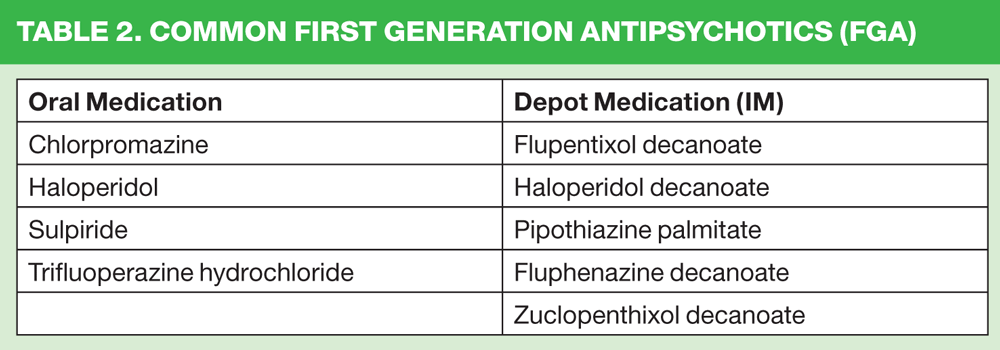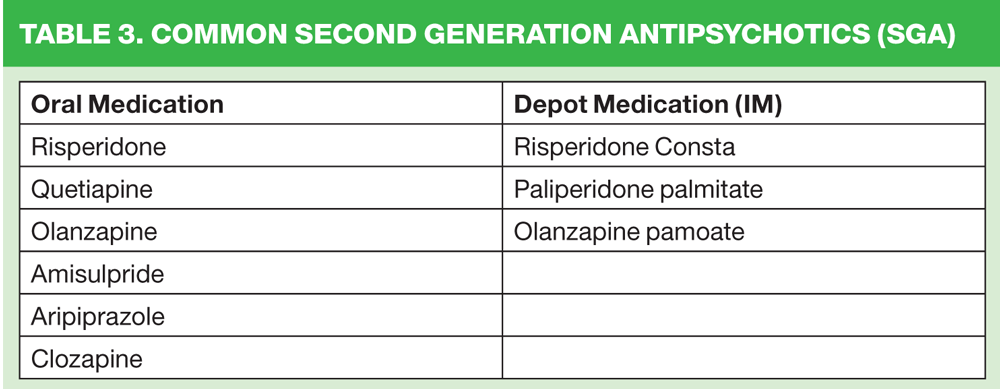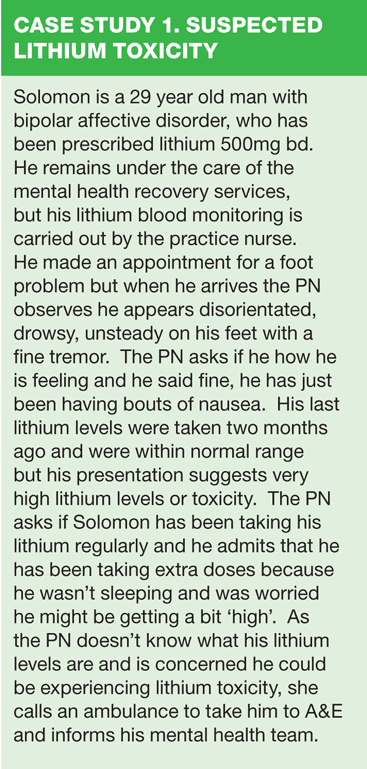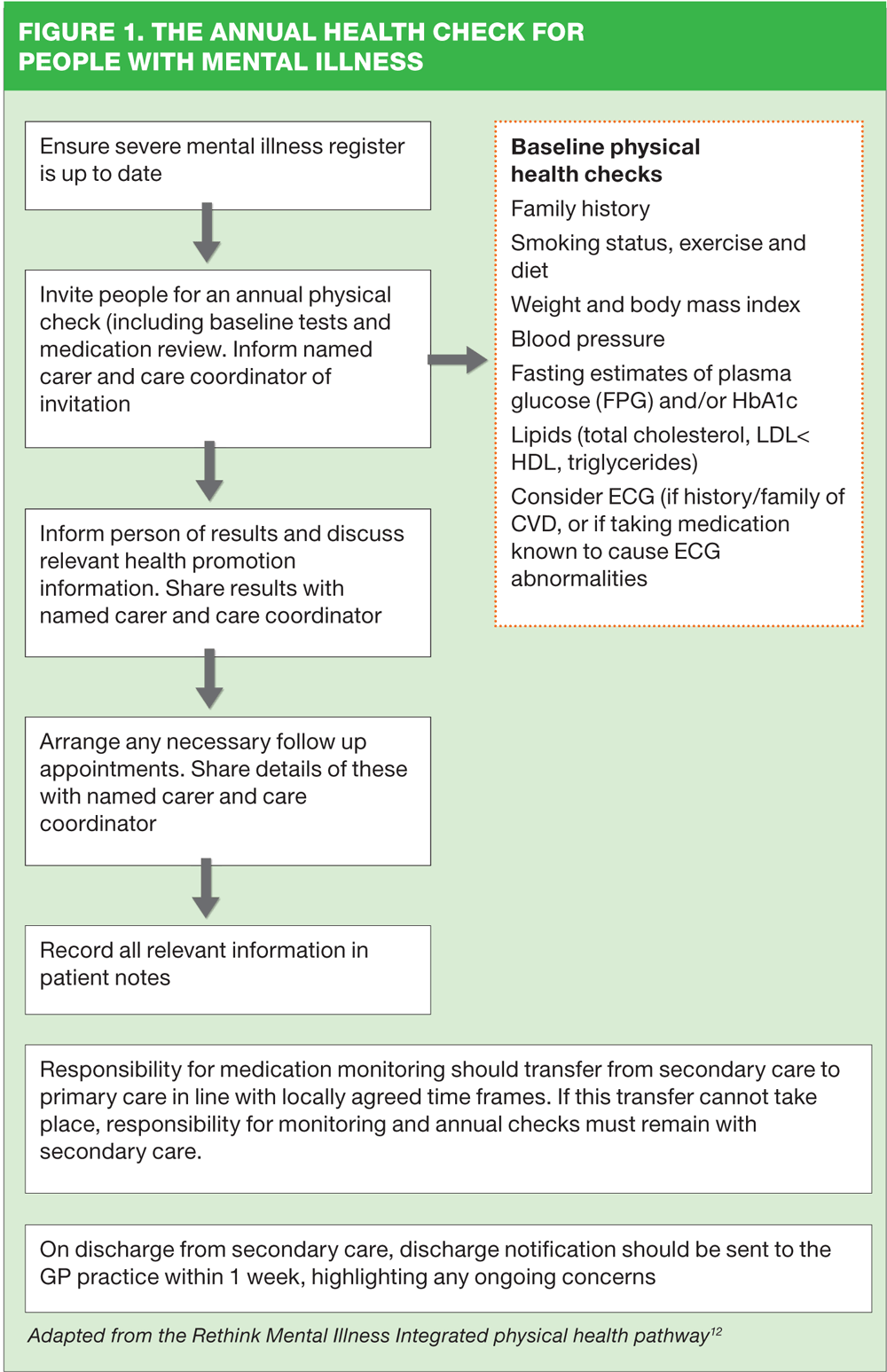Managing long term mental health conditions in primary care
Louise Saxton
Louise Saxton
RMN
Mental Health Clinical Nurse Specialist
Over the past 20 years the life expectancy of people with a serious mental illness has declined to 20% below that of the general population. So what can practice nurses do to help improve the physical health of patients with a psychiatric disorder?
Increasingly the routine management of people with a serious mental illness takes place in primary care rather than the secondary sector. However, there is evidence that they are disadvantaged when it comes to their physical health.1
Patients with serious mental health conditions have higher death rates than the population as a whole as a result not only of a combination of more risk factors associated with long term mental illness but also because they generally have poorer access to physical healthcare than the general population.1
It is estimated that at any one time, 220,000 people in England experience psychotic symptoms.2 The prevalence of bipolar disorder, which has a peak onset between 15 and 19 years of age, is about 1-2% of the UK population although bipolar spectrum disorder may affect as many as 8%.3 Less than 1% (0.72%) have schizophrenia. 3 People with schizophrenia or bipolar disease die up to 25 years earlier than the general population.3
Of those people diagnosed with schizophrenia, 45% recover after one or more episodes, about 20% show unremitting symptoms and disability, and the remaining 35% show a mixed pattern with varying periods of remission and relapse.2 Of those diagnosed with bipolar disorder, the ratio of remission to new episodes remains flat over 30 to 40 years after onset, indicating constant risk of recurrence up to the age of 70 or more. The recurrence risk of bipolar disorders (0.40 episodes per year) is about twice that of depression (0.20 episodes per year).4
The risk factors contributing to the increased risk of premature mortality include a higher prevalence of some types of cancer; the adverse effects of some psychiatric medications; and higher rates of suicide, accidental and violent death than for the general population. Lifestyle factors also adversely affect the physical health of people with mental illness, for example relatively low rates of exercise and poor diet. People with mental illness are less likely to practise safe sex and women, in particular, are more likely to be coerced and sexually exploited. These factors, combined with higher rates of smoking, further contribute to higher rates of hypertension, cardiovascular disease, obesity and diabetes.1
People with psychotic illnesses have a two-to-three times higher incidence of type 2 diabetes, and are twice as likely to die from heart disease as the general population. Furthermore, people with schizophrenia who develop cancer are three times more likely to die than other cancer patients. Almost twice as many people with psychotic illness smoke compared with the general population (61% and 33% , respectively).2 Finally substance misuse among people with schizophrenia is 47% and with bipolar disorder 60%, compared with 16% in the general population.5
SCHIZOPHRENIA
Schizophrenia describes a major psychiatric disorder (or cluster of disorders) that alters a person's perception, thoughts, affect and behaviour. Individuals who develop schizophrenia each have their own unique combination of symptoms and experiences, the precise pattern of which will be influenced by their particular circumstances.6
The two main groups of symptoms are shown in Table 1.7
"ƒ
BIPOLAR AFFECTIVE DISORDER
Bipolar disorder is a serious mental illness, which is tightly associated with psychosis, though it is recognised that not all people who experience mania and depression become psychotic and therefore psychosis should not be required for a diagnosis.7 Characterised by both episodes of depressed mood and episodes of elated mood (mania or hypomania) cases often remain unrecognised (mainly misdiagnosed as unipolar depression).8 Bipolar is a cyclical mood disorder involving periods of significant disruption to mood and behaviour and the key feature is the experience of hypomania or mania; grandiose and unreserved affect associated with increased drive and decreased sleep.8
There are three distinct categories:
Bipolar I Full-blown manic episodes (most commonly interspersed with episodes of major depression)
Bipolar II Depressive episodes and less severe manic symptoms, classed as hypomanic episodes
Cyclothymia Recurrent hypomanic and subclinical episodes of depression. The depressive episodes do not reach sufficient severity or duration to merit a diagnosis of a major depressive episode, but mood disturbance is a continuing problem for the patient and interferes with everyday functioning.
ANTIPSYCHOTIC MEDICATIONS
Antipsychotic drugs are regarded as the cornerstone of treatment for schizophrenia and psychosis but existing medications can have unpleasant side effects. However, in the Schizophrenia Commission Report 2012 survey, when asked what was the single most effective support for managing schizophrenia and psychosis, most people said medication. When asked what treatment was most helpful, again medication was rated most highly by 73% of respondents and is the foundation upon which personal recovery is built for many sufferers.2
There are two groups of medications, 'first-generation antipsychotics' (FGAs) previously referred to as 'conventionals' or 'typicals' (Table 2) and 'second generation antipsychotics' (SGAs) (Table 3) previously called 'atypicals'. They are used in the treatment and management of schizophrenia, treatment of acute episodes, for relapse prevention, for emergency treatment of acute behavioural disturbance (rapid tranquillisation) and to reduce symptoms. Olanzapine, quetiapine and risperidone (SGA) are also licensed in the UK for the treatment of acute mania. They are available as oral and intramuscular preparations, or as medium — or long-acting depot intramuscular (IM) preparations.
Antipsychotics are usually prescribed within the dose range recommended in their respective Summary of Product Characteristics, and there is little evidence to support the use of higher doses or a combination with another antipsychotic, even if monotherapy proves to be ineffective.
In the UK, clozapine (SGA) is only licensed for use with 'treatment-resistant' schizophrenia, when there is a lack of satisfactory clinical improvement despite adequate doses of at least two different antipsychotic, including an atypical antipsychotic, prescribed for an adequate period.
Antipsychotics are also used in combination with a range of other classes of drugs, such as mood stabilisers, anticonvulsants, antidepressants, anticholinergics, and benzodiazepines.9
"ƒ
Side Effects
All antipsychotic drugs have associated side effects, which differ from drug to drug and for each individual. These can include extra pyramidal side effects (acute dystonia, akathisia, parkinsonism, and tardive dyskinesia); autonomic effects (such as blurring of vision, increased intra-ocular pressure, dry mouth and eyes, constipation, urinary retention), increased prolactin levels, sedation and weight gain. Cardiac safety is also an issue because several antipsychotics have been shown to prolong ventricular repolarisation, which is associated with an increased risk of ventricular arrhythmias. With clozapine, routine monitoring is required prior and throughout treatment because of the risk of neutropenia and agranulocytosis.9
MOOD STABILISERS
Lithium
Lithium is indicated in the prevention of bipolar affective disorder, as it reduces both the number and severity of relapses and is effective in the treatment of moderate to severe mania. Lithium is more effective at preventing manic than depressive relapse, offering some protection against antidepressant-induced hypomania. NICE supports the use of lithium as a first-line mood-stabiliser.8 It is estimated that 15% of people with bipolar disorder take their own life and clinical trials concluded that lithium reduced the risk of attempted and completed suicide by 80%. Dose ranges differ between brands, at initiation and during treatment. There are also variations in plasma levels and individual response to treatment. The British National Formulary (BNF) recommends that the minimum effective plasma level for prophylaxis is 0.4 mmol/l, with the optimal range being 0.6—0.75 mmol/l. Levels above 0.75 mmol/l offer additional protection only against manic symptoms.9
Lithium toxicity
Toxic effects occur predictably at levels >1.5 mmol/l and usually consist of gastrointestinal effects (increasing anorexia, nausea and diarrhoea) and CNS effects (muscle weakness, drowsiness, ataxia, course tremor and muscle twitching). Above 2 mmol/l, increased disorientation and seizures usually occur, which can progress to coma, and ultimately death. In the presence of more severe symptoms, osmotic or forced alkaline diuresis should be used (note, NEVER thiazide or loop diuretics). Above 3 mmol/l peritoneal or haemodialysis is often used. These plasma levels are only a guide and individuals vary in their susceptibility to symptoms of toxicity.10
Side Effects
Most side effects are dose- (plasma level) related and include mild gastrointestinal upset, fine tremor, polyuria and polydipsia. Polyuria may occur more frequently with twice-daily dosing. Propranolol can be useful in lithium-induced tremor. Some skin conditions such as psoriasis and acne can be aggravated by lithium therapy, which can also cause a metallic taste in the mouth, ankle oedema and weight gain. Lithium can cause a reduction in urinary concentrating capacity — nephrogenic diabetes insipidus — therefore thirst and polyuria occur. This effect is usually reversible in the short to medium term, but may be irreversible after long-term treatment (>15 years). Lithium treatment can also lead to a reduction in the glomerular filtration rate although in the majority of patients this effect is considered to be benign.10
Interactions with other drugs
ACE inhibitors can reduce thirst which can lead to mild dehydration, and increase renal sodium (Na) loss, leading to increased Na re-absorption by the kidney, leading to an increase in lithium plasma levels. The risk seems to be increased in patients with heart failure, dehydration and renal impairment. ACE inhibitors can also precipitate renal failure so, if co-prescribed with lithium, more frequent monitoring of e-GFR and plasma lithium is required.
Diuretics can reduce the renal clearance of lithium, the degree being greater with thiazide than loop diuretics.
NSAIDs inhibit the synthesis of renal prostaglandins, reducing renal blood flow and possibly increasing renal re-absorption of sodium and therefore lithium. Risk appears to increase in patients who have impaired renal function, renal artery stenosis or heart failure and dehydrated or on a low-salt diet.
Finally carbamazapine can cause hyponatraemia and may lead to lithium retention and toxicity.9
OTHER MOOD STABILISERS
Other mood stabilisers frequently used are the anticonvulsants, sodium valproate and carbamazepine. Although these drugs are more often used to treat epilepsy, they are also effective in treating bipolar disorder. They are sometimes used to treat episodes of mania, but like lithium, they are generally used as long-term mood stabilisers. A single anticonvulsant medicine may be used or, where the condition does not respond to lithium on its own, they may be used in combination with lithium.
Sodium valproate is not usually prescribed for women of child-bearing age because there is a risk that it could damage an unborn child. However, if there is no alternative, you will need to ensure that the woman is using a reliable form of contraception. Common side effects include sleepiness, dizziness, increased appetite and weight gain, nausea and vomiting, changes in blood count and menstrual irregularities. Rarely, valproate can cause pancreatitis or liver failure. Routine monitoring therefore includes full blood count and liver function tests every six months.
Carbamazepine is usually only prescribed on specialist advice, particularly for people who have rapid-cycling bipolar disorder. It is started at a low dose and gradually titrated upwards, to minimise the risk of side effects at the start of treatment. As with sodium valproate, monitor blood count and liver function, and also kidney function, six monthly. It should not be co-prescribed with lithium because of the increased risk of lithium toxicity.
ANTIDEPRESSANTS
In managing acute depressive symptoms with bipolar disorder, antidepressants are often prescribed though carry the risk of 'switching' the person to a manic state, and may be involved in cycle acceleration (mood destabilisation). There is only a limited role for maintenance treatment with antidepressants in bipolar depression: preventative medication has a greater role. When prescribing an antidepressant, a mood stabilizer (e.g. lithium, sodium valproate or carbamezapine) should also be prescribed.8
Stopping antidepressants
When a patient is in remission from depressive symptoms (or symptoms have been significantly less severe for 8 weeks), stopping the antidepressant medication should be considered, to minimise the risks of switching to mania and increased rapid cycling. The dose of antidepressant should be gradually reduced over several weeks, while maintaining the antimanic medication. Particular care is needed with paroxetine and venlafaxine because they are associated with a higher risk of discontinuation/withdrawal symptoms.8 In the light of reports of suicidal ideation associated with selective serotonin re-uptake inhibitors (SSRIs), patients should be monitored closely in the first weeks of treatment.11
Side Effects
Other side effects associated with the SSRIs include insomnia, sexual dysfunction, hyponatraemia, GI bleeds. Paroxetine has been associated with more weight gain and a higher incidence of sexual dysfunction, and sertraline with a higher incidence of diarrhoea.9
ASSESSING PHYSICAL HEALTH
It is now accepted that people with psychotic illnesses are also at a higher risk of physical illness compared with the general population, so it is important to monitor their physical health at least once a year. The main focus should be on cardiovascular disease risk assessment because of patients with these conditions are at higher risk than the general population.1 General physical assessment should encompass smoking, poor diet and lack of exercise. In addition, antipsychotic drugs may affect glucose regulation, increasing the risk of the metabolic syndrome, (hypertension, central obesity, glucose intolerance or insulin resistance and dyslipidaemia), which is a predictor of Type 2 diabetes and coronary heart disease. Rethink Mental Illness, Royal College of Nursing, Royal College of General Practitioners and Royal College of Psychiatrists have developed an integrated physical health pathway, which sets out the for primary role and responsibilities for monitoring the physical health of patients with mental health conditions.12 See Figure 1.
CONCLUSION
Up to half of patients who have a serious mental illness are seen only in a primary care setting, and the majority of stable patients with severe mental illness with low level recurrent symptoms will be managed in primary care. Therefore it is vital that primary care is able to effectively manage long term mental health conditions and assess mental state, medication effects, and lifestyle. However, while addressing the patient's mental health it is critically important not to overlook their physical health.
Louise Saxton is employed in a non-promotional, educational role as a Clinical Nurse Specialist in Mental Health by Janssen-Cilag Ltd, as part of a Service to Medicine.
REFERENCES
1. Thornicroft G. Physical health disparities and mental illness: the scandal of premature mortality. B J Psych 2011;199:441-442.
2. THE ABANDONED ILLNESS: A report by the Schizophrenia Commission 2012. Available at: http://www.rethink.org/media/514093/TSC_main_report_14_nov.pdf
3. Reilly S, Planner C, Hann M, et al. The Role of Primary Care in Service Provision for People with Severe Mental Illness in the United Kingdom. PLOS One 2012; 77(5):e36468
4. Angst J, Gamma A, Sellaro R, et al. Recurrence of bipolar disorders and major depression: A life-long perspective. Eur Arch Psychiatry Clin Neurosci 2003;253:236—240
5. NICE. Psychosis with Coexisting Substance Misuse: Assessment and Management in Adults and Young People. National Clinical Guideline 120, National Collaborating Centre for Mental Health, 2011. Available at: http://guidance.nice.org.uk/CG120/Guidance
6. NICE. Schizophrenia: The NICE Guideline on Core Interventions in the Treatment and Management of Schizophrenia in Adults in Primary and Secondary Care (Updated edition) National Collaborating Centre for Mental Health 2010. Available at: http://guidance.nice.org.uk/CG82/Guidance/pdf/English
7. Mental Health Matters in Primary Care: Ruth Chambers, Elizabeth Boath, Gill Wakely. 2001 Redcliffe Medical Press Ltd
8. NICE. Bipolar Disorder: Management of Bipolar Disorder in Adults, Children and Adolescents in Primary and Secondary Care. National Collaborating Centre for Mental Health (NCCMH) 2006. Available at: http://www.nice.org.uk/nicemedia/live/10990/30194/30194.pdf
9. British National Formulary 65 March — September 2013
10. Taylor D, Oaton C, Kapur S (Eds). The Maudsley Prescribing Guidelines in Psychiatry 11th Edition Oxford; Wiley-Blackwell: 2012
11. Gunnell D, Saperia J, Ashby D. Selective serotonin re-uptake inhibitors (SSRIs and suicide in adults: meta-analysis of drug company data"¦BMJ 2005;330:385. Available at: http://www.bmj.com/content/330/7488/385]
12. Rethink Mental Illness. Integrated physical health pathway. Available at: http://www.rcpsych.ac.uk/pdf/NAS%20Integrated%20Physical%20Health%20Pathway%20Dec%2012.pdf





